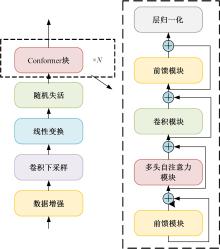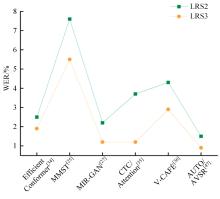吉林大学学报(工学版) ›› 2024, Vol. 54 ›› Issue (10): 2984-2993.doi: 10.13229/j.cnki.jdxbgxb.20240209
• 计算机科学与技术 • 上一篇
基于联结主义的视听语音识别方法
车娜1,2,3( ),朱奕明1,赵剑1,2,3(
),朱奕明1,赵剑1,2,3( ),孙磊1,史丽娟2,3,4,曾现伟1
),孙磊1,史丽娟2,3,4,曾现伟1
- 1.长春大学 计算机科学技术学院,长春 130022
2.长春大学 吉林省人体健康状态辨识与机能增强重点实验室,长春 130022
3.长春大学 残障人士智能康复及无障碍教育部重点实验室,长春 130022
4.长春大学 电子信息工程学院,长春 130022
Connectionism based audio-visual speech recognition method
Na CHE1,2,3( ),Yi-ming ZHU1,Jian ZHAO1,2,3(
),Yi-ming ZHU1,Jian ZHAO1,2,3( ),Lei SUN1,Li-juan SHI2,3,4,Xian-wei ZENG1
),Lei SUN1,Li-juan SHI2,3,4,Xian-wei ZENG1
- 1.School of Computer Science and Technology,Changchun University,Changchun 130022,China
2.Jilin Provincial Key Laboratory of Human Health State Identification and Function Enhancement,Changchun University,Changchun 130022,China
3.Key Laboratory of Intelligent Rehabilitation and Barrier?free Access for the Disabled,Ministry of Education,Changchun University,Changchun 130022,China
4.School of Electronic and Information Engineering,Changchun University,Changchun 130022,China
摘要:
针对视听语音识别技术存在的数据需求量大、音视频数据对齐、噪声鲁棒性等问题,深入分析了联结主义时序分类器、长短期记忆神经网络、Transformer、Conformer四类核心模型的特点与优势,归纳了各模型的适用场景,并提出了优化模型性能的思路和方法。基于主流数据集和常用评价标准,对模型性能进行了量化分析。结果表明:CTC在噪声条件下性能波动较大,LSTM能有效捕捉长时序依赖,Transformer和Conformer在跨模态任务中可显著降低识别错误率。最后,从自监督训练和噪声鲁棒性两个层面,展望了未来的研究方向。
中图分类号:
- TN912.34
| 1 | Ibrahim T W S a M Z. A review of audio-visual speech recognition[J].Journal of Telecommunication, Electronic and Computer Engineering,2018,10(1-4):35-40. |
| 2 | 苏荣峰.多重影响因素下的语音识别系统研究[D].深圳:中国科学院大学中国科学院深圳先进技术研究院,2020. |
| Su Rong-feng.Research on speech recognition system under multiple influencing factors[D].Shenzhen:Shenzhen Institutes of Advanced Technology,Chinese Academy of Sciences,2020. | |
| 3 | Tamura S, Ninomiya H, Kitaoka N, et al. Audio-visual speech recognition using deep bottleneck features and high-performance lipreading[C]∥Asia-Pacific Signal and Information Processing Association Annual Summit and Conference, Hongkong,China,2015:575-582. |
| 4 | Zeng Z, Tu J, Pianfetti B, et al. Audio-visual affect recognition through multi-stream fused HMM for HCI[C]∥IEEE Computer Society Conference on Computer Vision and Pattern Recognition (CVPR'05), DiegoSan,America,2005:967-972. |
| 5 | 魏斌. 符号主义与联结主义人工智能的融合路径分析[J].自然辩证法研究,2022,38(2): 23-29. |
| Wei Bin. Analysis of the integration path of symbolism and connectionism of artificial intelligence[J].Study of Dialectics of Nature,2022,38(2):23-29. | |
| 6 | Zhang B, Zhu J, Su H.Toward the third generation artificial intelligence[J].Science China Information Sciences, 2023, 66(2): 1-19. |
| 7 | 焦李成, 杨淑媛, 刘芳, 等. 神经网络七十年:回顾与展望[J].计算机学报,2016,39 (8):1697-1716. |
| Jiao Li-cheng, Yang Shu-yuan, Liu Fang, et al. Seventy years of neural networks: retrospect and prospect[J]. Chinese Journal of Computers,2016,39(8):1697-1716. | |
| 8 | Ivanko D, Ryumin D, Karpov A. A review of recent advances on deep learning methods for audio-visual speech recognition[J].Mathematics, 2023, 11(12): 2665. |
| 9 | Wang D, Wang X D, Lyu S H.An overview of end-to-end automatic speech recognition[J].Symmetry, 2019, 11(8): 1018. |
| 10 | Yu W, Zeiler S, Kolossa D. Fusing information streams in end-to-end audio-visual speech recognition[C]∥IEEE International Conference on Acoustics, Speech and Signal Processing(ICASSP), Toronto, Canada, 2021: 3430-3434. |
| 11 | Tsunoda R, Aihara R, Takashima R, et al. Speaker-targeted audio-visual speech recognition using a hybrid CTC/attention model with interference loss[C]∥IEEE International Conference on Acoustics, Speech and Signal Processing(ICASSP), Singapore, Singapore, 2022: 251-255. |
| 12 | Yu W, Zeiler S, Kolossa D. Reliability-based large-vocabulary audio-visual speech recognition[J].Sensors, 2022, 22(15): 5501. |
| 13 | Lee Y H, Jang D W, Kim J B, et al. Audio–visual speech recognition based on dual cross-modality attentions with the Transformer model[J].Applied Sciences, 2020, 10(20): 7263. |
| 14 | Petridis S, Stafylakis T, Ma P, et al. Audio-visual speech recognition with a hybrid CTC/attention architecture[C]∥IEEE Spoken Language Technology Workshop(SLT), Athens, Greece, 2018:513-520. |
| 15 | Xu K, Li D W, Cassimatis N, et al. LCANet: end-to-end lipreading with cascaded attention-CTC[C]∥2018 13 th IEEE International Conference on Automatic Face & Gesture Recognition (FG 2018), Xi'an, China, 2018: 548-555. |
| 16 | 姜囡, 庞永恒, 高爽. 基于注意力机制语谱图特征提取的语音识别[J].吉林大学学报:理学版,2024,62(2): 320-330. |
| Jiang Nan, Pang Yong-heng, Gao Shuang. Speech recognition based on attention mechanism and spectrogram feature extraction[J].Journal of Jilin University(Science Edition),2024,62(2): 320-330. | |
| 17 | Chan W, Jaitly N, Le Q V, et al. Listen, attend and spell[C]∥Proceedings of the 2016 IEEE International Conference on Acoustics, Speech and Signal Processing(ICASSP), Shanghai,China,2015: 20-25. |
| 18 | Chung J S, Senior A W, Vinyals O, et al. Lip reading sentences in the wild[C]∥Computer Vision and Pattern Recognition, Honolulu,America,2017: 3444-3453. |
| 19 | Fernandez-Lopez A, Karaali A, Harte N, et al. Cogans for unsupervised visual speech adaptation to new speakers[C]∥IEEE International Conference on Acoustics, Speech and Signal Processing(ICASSP), Barcelona,Spain,2020:6294-6298. |
| 20 | Yu C C, Yu J Q, Qian Z P, et al. Improvement of acoustic models fused with lip visual information for low-resource speech[J].Sensors,2023,23(4): No.2071. |
| 21 | Petridis S, Li Z, Pantic M. End-to-end visual speech recognition with LSTMs[C]∥IEEE International Conference on Acoustics, Speech and Signal Processing(ICASSP), Los Angeles,America,2017:2592-2596. |
| 22 | 李健, 熊琦, 胡雅婷, 等. 基于Transformer和隐马尔科夫模型的中文命名实体识别方法[J].吉林大学学报:工学版,2023,53(5):1427-1434. |
| Li Jian, Xiong Qi, Hu Ya-ting, et al. Chinese named entity recognition method based on Transformer and hidden markov model[J].Journal of Jilin University(Engineering and Technology Edition),2023,53(5): 1427-1434. | |
| 23 | Bhatia S, Richie R. Transformer networks of human conceptual knowledge[J]. Psychological Review,2024, 131(1): 271-306. |
| 24 | Serdyuk D, Braga O, Siohan O. Transformer-based video front-ends for audio-visual speech recognition for single and multi-person video[C]∥Interspeech 2022, Incheon, Korea, 2022: 2833-2837. |
| 25 | Song Q Y, Sun B, Li S T. Multimodal sparse Transformer network for audio-visual speech recognition[J].IEEE Transactions on Neural Networks and Learning Systems,2022, 34(12): 10028-10038. |
| 26 | Wei L, Zhang J, Hou J, et al. Attentive fusion enhanced audio-visual encoding for Transformer based robust speech recognition[C]∥Asia-Pacific Signal and Information Processing Association Annual Summit and Conference(APSIPA ASC), Auckland,New Zealand,2020: 638-643. |
| 27 | Hu Y C, Chen C, Li R Z, et al. MIR-GAN: refining rrame-level modality-invariant representations with adversarial network for audio-visual speech recognition[C]∥Annual Meeting of the Association for Computational Linguistics, Toronto, Canada, 2023:11610-11625. |
| 28 | Li D S, Gao Y, Zhu C Y, et al. Improving speech recognition performance in noisy environments by enhancing lip reading accuracy[J]. Sensors, 2023, 23(4):No.2053. |
| 29 | Lian J C, Baevski A, Hsu W-N, et al. AV-data2vec: self-supervised learning of audio-visual speech representations with contextualized target representations[C]∥IEEE Automatic Speech Recognition and Understanding Workshop(ASRU), Taipei, China, 2023: 1-8. |
| 30 | Shi B, Hsu W-N, Mohamed A. Robust self-supervised audio-visual speech recognition[C]∥Conference of the International Speech Communication Association, Incheon, Korea, 2022:2118-2122. |
| 31 | Pan X C, Chen P Y, Gong Y C, et al. Leveraging unimodal self-supervised learning for multimodal audio-visual speech recognition[C]∥Annual Meeting of the Association for Computational Linguistics, Dublin, Ireland, 2022:4491-4503. |
| 32 | Yu C C, Su X S, Qian Z P. Multi-stage audio-visual fusion for dysarthric speech recognition with pre-trained models[J]. IEEE Transactions on Neural Systems and Rehabilitation Engineering, 2023, 31: 1912-1921. |
| 33 | 陈焯辉, 林绰雅, 刘奕显, 等. 基于多模态融合的端到端中文唇读识别研究[J].科学技术创新,2023(10):85-88. |
| Chen Zhuo-hui, Lin Chuo-ya, Liu Yi-xian, et al. Research on end-to-end Chinese lip reading recognition based on multimodal fusion[J]. Scientific and Technological Innovation, 2023(10): 85-88. | |
| 34 | Maxime B, Radu T. Audio-visual efficient Conformer for robust speech recognition[C]∥Proceedings of the IEEE/CVF Winter Conference on Applications of Computer Vision, Waikoloa, America, 2023: 2257-2266. |
| 35 | Ma P C, Petridis S, Pantic M. End-to-end audio-visual speech recognition with Conformers[C]∥IEEE International Conference on Acoustics, Speech, and Signal Processing, Toronto, Canada, 2021:7613-7617. |
| 36 | Hong J, Kim M, Yoo D, et al. Visual context-driven audio feature enhancement for robust end-to-end audio-visual speech recognition[C]∥Conference of the International Speech Communication Association, Incheon, Korea, 2022: 2838-2842. |
| 37 | Ma P C, Haliassos A, Fernandez-Lopez A, et al. Auto-AVSR: audio-visual speech recognition with automatic labels[J/OL].[2023-06-07].. |
| 38 | Liu X B, Lakomkin E, Vougioukas K, et al. SynthVSR: scaling up visual speech recognition with synthetic supervision[C]∥Proceedings of the IEEE/CVF Conference on Computer Vision and Pattern Recognition, Vancouver, Canada, 2023: 18806-18815. |
| 39 | Ren X, Li C, Wang S, et al. Practice of the conformer enhanced Audio-Visual Hubert on Mandarin and English[C]∥IEEE International Conference on Acoustics, Speech and Signal Processing(ICASSP), Rhodes, Greece, 2023: 1-5. |
| 40 | Afouras T, Chung J S, Senior A, et al. Deep audio-visual speech recognition[J]. IEEE Transactions on Pattern Analysis and Machine Intelligence,2018, 44(12): 8717-8727. |
| 41 | Triantafyllos A, Chung J S, Zisserman A. LRS3-TED: a large-scale dataset for visual speech recognition[J/OL]. [2018-10-12].. |
| 42 | Zhao Y, Xu R, Song M. A cascade sequence-to-sequence model for Chinese Mandarin lip reading[C]∥ACM International Conference on Multimedia in Asia, Beijing, China, 2019: 1-6. |
| 43 | Zhao Y, Xu R, Wang X, et al. Hearing lips: improving lip reading by distilling speech recognizers[C]∥The Thirty-Fourth AAAI Conference on Artificial Intelligence, City of New York, America, 2020: 6917-6924. |
| 44 | Li J H, Li C D, Wu Y F, et al. Robust audio-visual ASR with unified cross-modal attention[C]∥IEEE International Conference on Acoustics, Speech and Signal Processing (ICASSP), Rhodes, Greece, 2023: 1-5. |
| [1] | 张磊,焦晶,李勃昕,周延杰. 融合机器学习和深度学习的大容量半结构化数据抽取算法[J]. 吉林大学学报(工学版), 2024, 54(9): 2631-2637. |
| [2] | 李路,宋均琦,朱明,谭鹤群,周玉凡,孙超奇,周铖钰. 基于RGHS图像增强和改进YOLOv5网络的黄颡鱼目标提取[J]. 吉林大学学报(工学版), 2024, 54(9): 2638-2645. |
| [3] | 乔百友,武彤,杨璐,蒋有文. 一种基于BiGRU和胶囊网络的文本情感分析方法[J]. 吉林大学学报(工学版), 2024, 54(7): 2026-2037. |
| [4] | 郭昕刚,何颖晨,程超. 抗噪声的分步式图像超分辨率重构算法[J]. 吉林大学学报(工学版), 2024, 54(7): 2063-2071. |
| [5] | 张丽平,刘斌毓,李松,郝忠孝. 基于稀疏多头自注意力的轨迹kNN查询方法[J]. 吉林大学学报(工学版), 2024, 54(6): 1756-1766. |
| [6] | 孙铭会,薛浩,金玉波,曲卫东,秦贵和. 联合时空注意力的视频显著性预测[J]. 吉林大学学报(工学版), 2024, 54(6): 1767-1776. |
| [7] | 陆玉凯,袁帅科,熊树生,朱绍鹏,张宁. 汽车漆面缺陷高精度检测系统[J]. 吉林大学学报(工学版), 2024, 54(5): 1205-1213. |
| [8] | 梁礼明,周珑颂,尹江,盛校棋. 融合多尺度Transformer的皮肤病变分割算法[J]. 吉林大学学报(工学版), 2024, 54(4): 1086-1098. |
| [9] | 李雄飞,宋紫萱,朱芮,张小利. 基于多尺度融合的遥感图像变化检测模型[J]. 吉林大学学报(工学版), 2024, 54(2): 516-523. |
| [10] | 杨国俊,齐亚辉,石秀名. 基于数字图像技术的桥梁裂缝检测综述[J]. 吉林大学学报(工学版), 2024, 54(2): 313-332. |
| [11] | 陈岳林,高铸成,蔡晓东. 基于BERT与密集复合网络的长文本语义匹配模型[J]. 吉林大学学报(工学版), 2024, 54(1): 232-239. |
| [12] | 霍光,林大为,刘元宁,朱晓冬,袁梦,盖迪. 基于多尺度特征和注意力机制的轻量级虹膜分割模型[J]. 吉林大学学报(工学版), 2023, 53(9): 2591-2600. |
| [13] | 金小俊,孙艳霞,于佳琳,陈勇. 基于深度学习与图像处理的蔬菜苗期杂草识别方法[J]. 吉林大学学报(工学版), 2023, 53(8): 2421-2429. |
| [14] | 耿庆田,刘植,李清亮,于繁华,李晓宁. 基于一种深度学习模型的土壤湿度预测[J]. 吉林大学学报(工学版), 2023, 53(8): 2430-2436. |
| [15] | 巫威眺,曾坤,周伟,李鹏,靳文舟. 基于多源数据和响应面优化的公交客流预测深度学习方法[J]. 吉林大学学报(工学版), 2023, 53(7): 2001-2015. |
|
||









